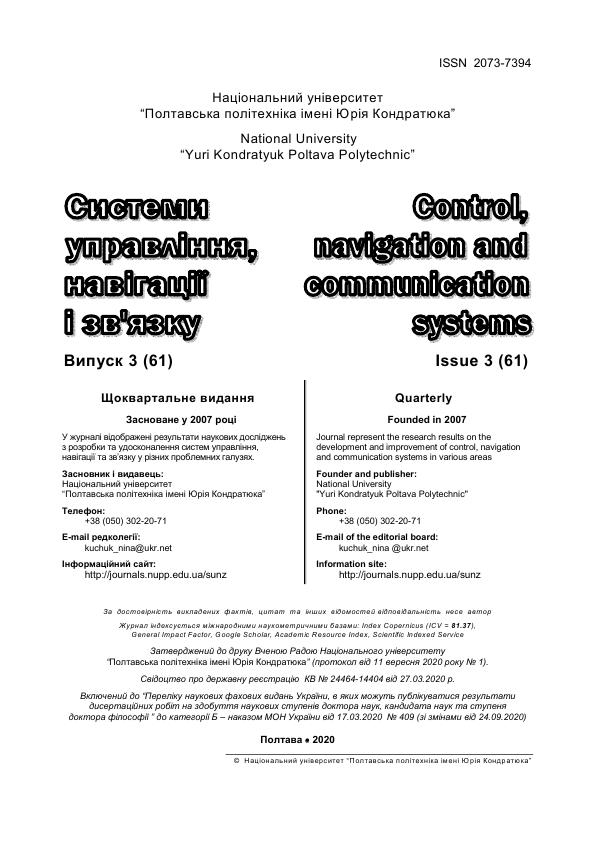ПІДВИЩЕННЯ ЕФЕКТИВНОСТІ КОМПОЗИЦІЙНИХ ЕЛЕКТРОМАГНІТНИХ ЕКРАНІВ РЕГУЛЮВАННЯМ МОРФОЛОГІЇ ФЕРОМАГНІТНОГО НАПОВНЮВАЧА
DOI:
https://doi.org/10.26906/SUNZ.2020.3.115Ключові слова:
електромагнітний екран, композиційний матеріал, коефіцієнт деполяризації, формула ДебаяАнотація
Встановлено, що при проектуванні композиційних металополімерних електромагнітних екранів необхідно врахувати морфологію частинок екрануючої субстанції – принаймні співвідношення довжини та товщини окремих частинок. Визначено, що різке зростання захисних властивостей відбувається за концентрацій екрануючих елементів, коли вони контактують між собою (критична концентрація). Найбільша критична концентрація (до 47 %) відповідає співвідношенню довжини та діаметру частинок 1:2. Зі зростанням співвідношення критична концентрація монотонно зменшується. За співвідношення 1:32 вона складає 15 %. Показано, що некоректні результати розрахунку діелектричної проникності композиційних матеріалів для визначення коефіцієнтів екранування, зокрема коефіцієнта відбиття електромагнітних хвиль обумовлені невірним розрахунком коефіцієнтів деполяризації, які є визначними щодо обчислення критичних об’ємних концентрацій провідної субстанції у матриці композиційного матеріалу. В свою чергу значення критичної концентрації входить до формули Оделевського для розрахунку діелектричної проникності гетерогенних композиційних матеріалів. Наведені розрахунки впливу співвідношення довжини та діаметра екрануючих елементів придатні для застосування (прогнозування функціоналу) тільки для композитів з вмістом однакових спеціально виготовлених екрануючих елементів. Розрахунки для умовно круглих (точкових) екрануючих частинок не збігаються з надійними експериментальними даними. Для такого наповнювача критична концентрація (за вагою) − 12−15 %. Прогнозування захисних властивостей композитів з використанням дрібнодисперсної субстанції (принаймні до розмірів частинок 150−200 мкм) доцільно здійснювати на основі визначення електрофізичних властивостей суміші. Наведено спосіб застосування для таких розрахунків формули Дебая для діелектричної проникності матеріалуЗавантаження
Посилання
Glyva V.A., Podoltsev A.D., Bolibrukh B.V., Radionov A.V. A Thin Electromagnetic Shield of a Composite Structure Made On the Basis of a Magnetic Fluid. Tekhnichna elektrodynamika. 2018. No 4. Р.14−18. DOI: https://doi.org/10.15407/techned2018.04.014
Glyva V., Podkopaev S., L. Levchenko, N. Karaieva, K. Nikolaiev, O. Tykhenko, O. Khodakovskyy, B. Khalmuradov. Design and study of protective properties of electromagnetic screens based on iron ore dust. Eastern-European Journal of Enterprise Technologies. 2018, Iss. 1/5 (91). PP. 10–17. DOI: https://doi.org/10.15587/1729-4061.2018.123622
Mondal S., Ganguly S., Das P., Khastgir D., Das N. C. Low percolation threshold and electromagnetic shielding effectiveness of nano-structured carbon based ethylene methyl acrylate nanocomposites // Composites Part B: Engineering. 2017. Vol. 119. P. 41–56.
Sukach, S., Riznik, D., Zachepa, N., Chenchevoy, V. (2020). Normalization of the Magnetic Fields of Electrical Equipment in Case of Unauthorized Influence on Critical Information Infrastructure Facilities. Soft Target Protection, 337–349. DOI: https://doi.org/10.1007/978-94-024-1755-5_28.
Богуш В.А. Модифицирование водными растворами углеродосодержащих иглопробивных полотен для экранов электромагнитного излучения. Доклады БГУИР. 2016. No3 (97). С. 95-98.
Valentyn Glyva V., Kasatkina N., Nazarenko V., Burdeina N., Karaieva N., Levchenko L., Panova O., Tykhenko О., Khalmuradov В., Khodakovskyy О. Development and study of protective properties of the composite materials for shielding the electromagnetic fields of a wide frequency range. Eastern-European Journal of Enterprise Technologies. 2020, Iss. 12 (104). PP. 40–47. DOI: https://doi.org/10.15587/1729-4061.2020.201330
Агафонова А.С., Беляев А.А., Кондрашов Э.К., Романов А.М. Особенности формирования монолитных конструкционных радиопоглощающих материалов на основе композитов, наполненных резистивным волокном. Авиационные материалы и технологии. 2013. No3 (28). C. 56−59.
Краев И.Д., Образцова Е.П., Юрков Г.Ю. Влияние морфологии магнитного наполнителя на радиопоглощающие характеристики композиционных материалов. Авиационные материалы и технологии. 2014. NoS2. C. 10−14.
Беспалова Е.Е., Беляев А.А., Широков В.В. Радиопоглощающие материалы для СВЧ-излучения высокой мощности. Труды ВИАМ. 2015. No3. C. 43−49.
Drmota A., Koselj J., Drofenik M., Žnidaršič A. Electromagnetic wave absorption of polymeric nanocomposites based on ferrite with a spinel and hexagonal crystal structure. Journal of Magnetism and Magnetic Materials. 2012. 324(6). PP. 1225–1229. DOI: https://doi.org/10.1016/j.jmmm.2011.11.015.
Glyva V., Lyashok J., Matvieieva I., Frolov V., Levchenko L., Tykhenko O., Panova O., Khodakovskyy O., Khalmuradov B., Nikolaiev K. Development and investigation of protective properties of the electromagnetic and soundproofing screen. Eastern-European Journal of Enterprise Technologies. 2018. Iss. 6/5 (96). P. 54–61. DOI: https://doi.org/10.15587/1729-4061.2018.150778
Хмельник Г.И., Бибиков С.Б. Cтатистический анализ зависимости параметров распределения Дебая от удельных сопротивлений слоев многослойного РПП. Технологии электромагнитной совместимости. 2012. No 4(43). С. 45−51.




